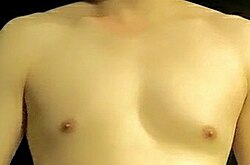| Breast | |
|---|---|
 | |
 Male human breasts with defined pectoral muscles | |
| Details | |
| Artery | Internal thoracic artery |
| Vein | Internal thoracic vein |
| Identifiers | |
| Latin | mamma (mammalis 'of the breast')[1] |
| MeSH | D001940 |
| TA98 | A16.0.02.001 |
| TA2 | 7097 |
| FMA | 9601 |
| Anatomical terminology | |
The breasts are two prominences located on the upper ventral region of the torso among humans and other primates. Both sexes develop breasts from the same embryological tissues. The relative size and development of the breasts is a major secondary sex distinction between females and males. There is also considerable variation in size between individuals. Female humans are the only mammals which permanently develop breasts at puberty; all other mammals develop their mammary tissue during the latter period of pregnancy; at puberty, estrogens, in conjunction with growth hormone, cause permanent breast growth.
In females, the breast serves as the mammary gland, which produces and secretes milk to feed infants.[2] Subcutaneous fat covers and envelops a network of ducts that converge on the nipple, and these tissues give the breast its distinct size and globular shape. At the ends of the ducts are lobules, or clusters of alveoli, where milk is produced and stored in response to hormonal signals.[3] During pregnancy, the breast responds to a complex interaction of hormones, including estrogens, progesterone, and prolactin, that mediate the completion of its development, namely lobuloalveolar maturation, in preparation of lactation and breastfeeding.
Along with their major function in providing nutrition for infants, several cultures ascribe social and sexual characteristics to female breasts, and may regard bare breasts in public as immodest or indecent. Breasts have been featured in ancient and modern sculpture, art, and photography. Breasts can represent fertility, femininity, or abundance. They can figure prominently in the perception of a woman's body and sexual attractiveness. Breasts, especially the nipples, can be an erogenous zone.
- ^ "mammal". Dictionary.reference.com. Archived from the original on 14 November 2011. Retrieved 31 October 2011.
- ^ "Breast – Definition of breast". Merriam-Webster. Archived from the original on 6 September 2015. Retrieved 21 October 2015.
- ^ "SEER Training: Breast Anatomy". National Cancer Institute. Archived from the original on 2 May 2012. Retrieved 9 May 2012.